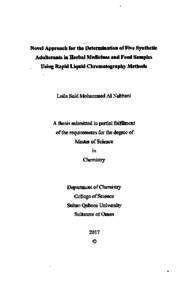وثيقة
Novel approach for the determination of five synthetic adulterants in herbal medicines and food samples using rapid chromatography methods
الناشر
Sultan Qaboos University
ميلادي
2017
اللغة
الأنجليزية
الموضوع
الملخص الإنجليزي
A simple and rapid method was developed for the determination of five common adulterants found in herbal medicines (HM) and food supplements (FS) including caffeine, hydrochlorothiazide, chlorpheniramine, diazepam and gliclazide using high performance liquid chromatography (HPLC) coupled to diode array detector (DAD). Initially, three columns were evaluated, hydrophilic interaction liquid chromatography (HILIC), monolithic (MC18) and porous graphitic carbon (PGC). Results showed that PGC and MC18 column gave good separation. HPLC-DAD method was developed for the qualitative and quantitative analysis of the five adulterants. The identification was based on the retention time of the five adulterants in MC18 and PGC columns. Additionally UV spectrum and peak purity test were also used for qualitative analysis. The quantitative analysis was carried out using UV absorbance at 254 nm of the five adulterants. The developed method was then fully validated in terms of accuracy, linearity, precision, limit of detection (LOD) and limit of quantification (LOQ). The LOD varied from 0.01 to 0.06 mg L" for both PGC and MC18 columns. The calibration curves were linear over a wide concentration range of 0.05-50 mg L and analytical recoveries were between 87.2 and 106 % for PGC column. On the other hand, the concentration range was 0.08-50 mg 1" and analytical recoveries were between 87.9 and 102.9 % for MC18 column. The developed method is accurate and precise, as well as having advantages such as simplicity and short duration of analysis. Finally, 25 samples of labelled as "natural" products were analyzed. Samples were supplied by the Public Authority of Costumer Protection (PACP), Ministry of Health (MOH) and some were purchased directly from the local market. Caffeine was detected in 20 % of the samples. Fortunately, concentration of caffeine in these 5 samples was within the allowable limit.
المجموعة
URL المصدر
الملخص العربي
تم تطوير طريقة بسيطة وسريعة لتحديد خمسة أنواع من المواد الكيميائية الأكثر شيوعا و الممكن استخدامها في الغش التجاري في الأدوية العشبية والمكملات الغذائية و هي الكافيين ، و هيدروكلوروثيازيد، و كلورفينيرامين مالیت، و دیزابام و غليكلازيد باستخدام جهاز فصل السوائل عالي الكفاءة ومجموعة الصمام الثنائي في البداية، تم تقييم ثلاثة أعمدة، وهذه هي: عمود الفصل لمحب للمياه ، و العمود ذو الجزيئات المتجانسة و العمود ذو المسامية الكربونية. وأظهرت النتائج أن العمود ذو المسامية الكربونية و العمود ذو الجزيئات المتجانسة أعطى فصل جيد. وقد تم تطوير طريقة الفصل للتحليل النوعي والكمي للأنواع الخمس المغشوشة تم إجراء التحليل الكمي باستخدام الامتصاصية للأشعة فوق البنفسجية باستخدام الطول الموجي 254 نانومتر ثم تم التحقق من صحة الطريقة المقدمة عن طريق حساب معايير الدقة. لقد تم رسم الرسم المعياري لكل المواد باستخدام التركيز من 0 . 05 إلى 50 مليغرام/ل و كان الانتعاش التحليلي بين 87. 2 و 106% في العمود ذو المسامية و الانتعاش الكربونية. بينما العمود ذو الجزيئات المتجانسة فكان التركيز يتراوح من 0. 08 إلى 50 مليغرام/ل التحليلي بين 87 . 9 و 102 . 9 %. الطريقة المقدمة طريقة دقيقة، فضلا عن وجود مزايا لها مثل البساطة والفترة القصيرة عند التحليل. أخيرا، تم تحليل 25 عينة من المنتجات المصنفة "طبيعية". تم توريد العينات من قبل الهيئة العامة لحماية المستهلك ، و وزارة الصحة وبعضها تم شراؤها مباشرة من السوق المحلية. تم الكشف عن الكافيين في 20% من العينات. لحسن الحظ، كان تركيز الكافيين في هذه العينات الخمس ضمن الحد المسموح به.
قالب العنصر
الرسائل والأطروحات الجامعية


